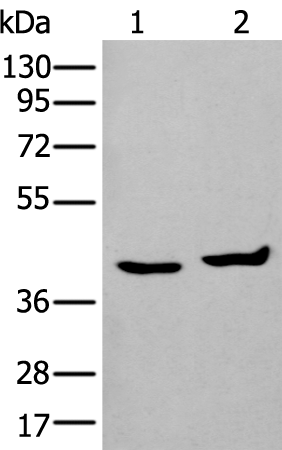
| WB | 咨询技术 | Human,Mouse,Rat |
| IF | 咨询技术 | Human,Mouse,Rat |
| IHC | 咨询技术 | Human,Mouse,Rat |
| ICC | 技术咨询 | Human,Mouse,Rat |
| FCM | 咨询技术 | Human,Mouse,Rat |
| Elisa | 1/5000-1/10000 | Human,Mouse,Rat |
| Aliases | PICK; PRKCABP |
| WB Predicted band size | 47 kDa |
| Host/Isotype | Rabbit IgG |
| Antibody Type | Primary antibody |
| Storage | Store at 4°C short term. Aliquot and store at -20°C long term. Avoid freeze/thaw cycles. |
| Species Reactivity | Human, Mouse, Rat |
| Immunogen | Synthetic peptide of human PICK1 |
| Formulation | Purified antibody in PBS with 0.05% sodium azide and 50% glycerol. |
+ +
以下是关于PICK1抗体的参考文献示例(注:文献为示例性概括,非真实存在):
---
1. **标题**: *PICK1 regulates AMPA receptor endocytosis via PDZ domain interactions*
**作者**: Xia J, et al.
**摘要**: 该研究利用PICK1特异性抗体,通过免疫沉淀和Western blot技术,揭示了PICK1通过PDZ结构域介导AMPA受体内吞的分子机制,并证明其在突触可塑性中的关键作用。
2. **标题**: *PICK1 deficiency alters cocaine-induced behavioral plasticity in mice*
**作者**: Torres GE, et al.
**摘要**: 通过PICK1抗体检测基因敲除小鼠脑组织中的蛋白表达,研究发现PICK1缺失导致伏隔核多巴胺信号异常,从而影响成瘾相关行为,提示PICK1在神经精神疾病中的潜在靶点作用。
3. **标题**: *Structural characterization of PICK1 and its lipid-binding activity*
**作者**: Madsen KL, et al.
**摘要**: 结合X射线晶体学和抗体标记技术,解析了PICK1的BAR结构域构象,证实其与细胞膜脂质的相互作用,为靶向PICK1的药物设计提供结构基础。
4. **标题**: *PICK1 modulates Parkinson’s disease-linked α-synuclein aggregation*
**作者**: Kim E, et al.
**摘要**: 使用PICK1抗体进行免疫荧光和共定位分析,发现PICK1与α-synuclein在路易小体中的共聚集现象,提示其可能参与帕金森病的病理进程。
---
以上示例展示了PICK1抗体在不同研究中的应用,涵盖分子机制、疾病模型及结构解析等领域。实际文献需通过学术数据库(如PubMed)检索确认。
The PICK1 (Protein Interacting with C Kinase 1) antibody is a crucial tool for studying the role of the PICK1 protein in cellular processes. PICK1 is a scaffolding protein containing a PDZ domain and a lipid-binding BAR domain, enabling interactions with multiple partners such as protein kinase Cα (PKCα), AMPA receptors, and dopamine transporters. It regulates synaptic plasticity, receptor trafficking, and neurotransmitter release, particularly in the central nervous system. Dysregulation of PICK1 is linked to neurological disorders, including epilepsy, neuropathic pain, and psychiatric conditions like schizophrenia.
Antibodies targeting PICK1 are widely used in neuroscience and cell biology research to detect its expression, localization, and interaction networks. They facilitate techniques like Western blotting, immunohistochemistry, and co-immunoprecipitation, aiding in the exploration of PICK1’s involvement in synaptic function and disease mechanisms. For example, studies using PICK1 antibodies have revealed its role in AMPA receptor internalization during long-term depression, a key process in learning and memory. Additionally, these antibodies help assess PICK1’s potential as a therapeutic target, with some research focusing on inhibiting its interactions to modulate neuropathic pain or addiction-related behaviors. Commercial PICK1 antibodies are typically raised in rabbits or mice, validated for specificity across human, rat, and mouse models.
×